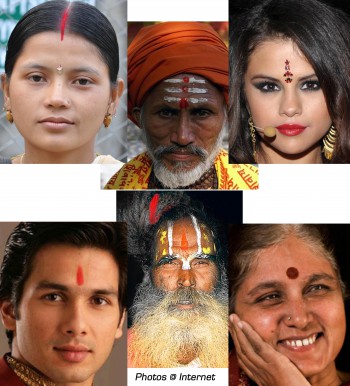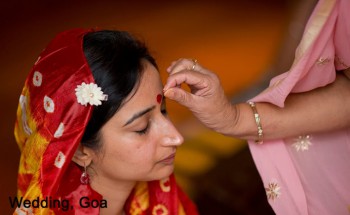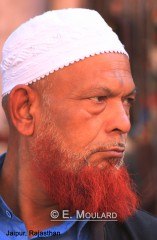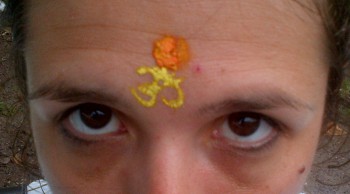04/14/2014
The Indian wedding for Dummies - 1. The arranged marriage
The "Indian wedding" (I should say the Hindu wedding to be exact) has made the subject of numerous books, movies, visits to India. In short it’s an institution. I will try here to understand something to it!
Arranged marriage: and why not?!
Let's make the distinction between arranged marriage and forced marriage.
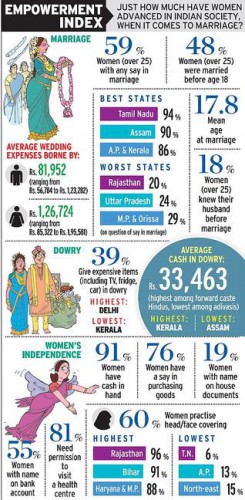 If I can de-dramatize arranged marriages (read below), it is impossible to do the same with forced marriages which are still widely practiced in India: 40% of women do not have a word in the choice of the husband, less than 20% of women (over 25) knew their husbands before the fateful day and worse, almost 50% of women have married before the legal age of 18 (source).
If I can de-dramatize arranged marriages (read below), it is impossible to do the same with forced marriages which are still widely practiced in India: 40% of women do not have a word in the choice of the husband, less than 20% of women (over 25) knew their husbands before the fateful day and worse, almost 50% of women have married before the legal age of 18 (source).
Which means that there are still thousands of people (Hindus) who, each year, follow the tradition and find out whom they are going spend the rest of their lives with only when they are already married: SURPRISE! As per the custom to groom arrives first, and his view is hidden with a bed sheet, which is removed once the bride is brought in by her maternal uncle and cousins and the consent of the parents exchanged. The bed sheet is simply a less sexy version (but more promising ;)) of the veil used in Catholic marriages, originally to hide the face of the bride (source).
The concept of arranged marriage, still very prevalent in India (more than 90% of cases), tends to shock the Westerners. Before crying wolf and saying Indians are horrible, remember that from the time of Ancient Rome to the 19th century (i.e. 2 500 small years), the marriage of convenience was the norm in our civilization. The family was then a “business of social or economic survival” and marriage a “contract” to ensure its sustainability*.
What about love in an arranged marriage? When a Westerner thinks of arranged marriage, he immediately gets the image of a pretty girl forced to marry a loser, too ugly and too stupid to find a woman by himself! While in fact, parents seek someone who matches as much as possible – and we can assume that they know their offspring pretty well! And the candidate has a whole lot of criteria to fill: religion, caste, skin colour (fairness being an essential criterion of beauty), income, location, diet (non-vegetarien vs vegetarian), horoscope to mention only but the most important.
Whatever said and done, it is likely that two “virgins of love”, that many things draw close (see above-mentioned criteria), which have been waiting for it since childhood, end up loving each other (they so want it!). The passion, the ignition of the body and desire, is less guaranteed but at the same time it is known to be ephemeral, isn’t it? ;)
Let's be honest: who has never felt, while celibacy and the thirties are at their full, as meetings on the Internet have only led to failures (ending up, at best, as entertaining sex buddies), as the stock of single friends’ friends is exhausted, when the anxiety of ending up as a lonely spinster eaten by her cat makes the ball in your throat so big even Häagen-Dazs doesn’t get down anymore : “if only my awesome parents who have (almost) always fulfilled my whims could find me the perfect match!” Who did not want to make this call, unthinkable, and yet potentially life-saving?!
In the same vein, it is a bit hypocritical to criticize arranged marriage when you see the success of online dating sites in the West (in 2007, 1 out of 8 married couple in the US met online! source)).
And then even if it is not written black on white, if it is not man-da-tory, despite our increasingly multicultural environments, we are still largely endogamic – most of my friends have married people from their tribe, and it is certainly easier to manage than for the eccentrics who get a partner from another country, another colour, another religion or another social class. Easier because two endogamic people only have to overcome the differences due to gender and personality and not all the others. But it is also probably less outlandish, enriching and rewarding!
So when you dig a little, you realize that what mostly shocks my fellow Westerners is not so much the “arrangement” itself but rather the idea of not having “tested the goods before purchase”, ending up on the wedding night in bed with an unknown person... I admit that in our culture where sex is ubiquitous, obsessive, glorified, overvalued (?), the idea is off-putting. In addition it is a bad one if I take the example of my (Indian) close friends’ experiences: unconsumed union, weird practices, very often the man is not “up to the mark” and this up till the divorce! Seeing a young couple on honeymoon who has nothing to say to each other in the first days (before things warm up) surprises me every time, and makes me reflect on the oddity (from my point of view) of the situation.
And yet it is still the rule. For the lucky ones, the “choice” to refuse an application is becoming increasingly available. So is the option to introduce someone (from school, from the office) and if the afore-mentioned criteria are met and that the union takes place, it will be called a “love marriage” (even if very often, there is no romantic relationship). Real love marriages, guided by passion and defying the afore-mentioned criteria, remain very rare and often end up in bloodshed (especially in under-privileged backgrounds).
That is why passion is exalted as the Holy Grail (something you dream of but will never get) in the movies, and in families as a trouble maker (the uncontrollable versus the social codes that govern a well-ordered life).
* “It is during the 18th century that the family ceased to be regarded as a business of social survival or economic to rely more and more on the feeling of love [...] The mentioned change was influenced by economic factors such as industrialization, opening markets, wage labour, the progressive improvement of conditions of life, but also by an encouragement of the Church and the State. […] We can see, for example, that today, despite the diversification of modern societies which are often multicultural, a trend quite generalized to contract endogamic marriages; the choice of the partner is often influenced by social origin, ethnic, racial or religious.” Source: http://www.asblcefa.be/cefa/images/pdf/9mariagearrange
“Marriage is first a contract between a man and a woman. Subsequently, free consent developed, and marriage for love gradually override the marriage of convenience during the nineteenth century, in parallel with the evolution of the role of women in society, aimed to being the equal of men. This process culminated with the legalization of divorcein 1884. » Source: http://www.mariages.net/articles/origines-et-histoire-du-mariage--c5102
08:00 Posted in Incredible India!, Why in India... | Permalink | Comments (0) | Tags: india, marriage, wedding, arranged marriage, forced marriage, love marriage, rites, ceremonies, rituals, divorce, sheet, mehndi, henna, baraat, sex, incompatibility, contract, classifieds, matrimonials, matchmaker, nayan, astrologers, horoscope, marry a tree, marry a pot, auspicious, date, joint family, kama sutra | ![]() Facebook | |
Facebook | |
10/14/2013
Why in India people have red marks on the forehead?
Or, if we dig deeper, Who, when, how, where?
We can distinguish different ‘marks’: the dot in the middle forehead, the line at the root of the hair and the lines and other designs on the forehead. These marks are often red, but not always. It’s not easy to understand the whole thing!
So who wears what? Does a red dot mean a woman is married?
In North India, the red dot on the forehead would be traditionally the prerogative of married women. But not in South India. Anyway it has become a fashion element, which varies in shape, color and material (the sticker – top right photo – has been giving tough competition to the traditional bindi – bottom right).
It seems however that the sindoor applied at the root of the hair (top left) is only applied by married women (a way of saying don’t touch! – like others do with a ring!).
Men can also wear the tilak, for religious or aesthetic reasons.
In fact anyone (Hindu or not, man or woman, Indian or not) will bear a red mark on the forehead after attending a puja (religious ceremony): whether it's a small prayer at home or in the temple, it always ends by a marking on the forehead...
So... why?
Firstly for aesthetic reasons: Indians find it beautiful! Tastes and colors are not to be discussed...
Secondly the dot on the forehead is a Hindu religious symbol since the tilak, placed on the sixth chakra (‘agna’), represents the third eye or the eye of the mind, associated with deities and the concepts of meditation and spiritual enlightenment. It was originally exclusively for ‘knowledge holders’: idols, priests, ascetics. (1) The Vishnu worshippers’ tilak is a U of white color (obtained from sandalwood) drawn around a red or black line (bottom middle photo). And for Shivaites it is formed by three horizontal lines made from ashes (top middle). (2)
But above all there is a 'scientific' explanation: the body– the forehead and the point 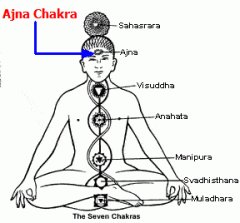 between the two eyes (seat of memory and thoughts) in particular – would produce energy in the form of electromagnetic waves. That’s how stress or anxiety creates heat and causes headaches. (1)
between the two eyes (seat of memory and thoughts) in particular – would produce energy in the form of electromagnetic waves. That’s how stress or anxiety creates heat and causes headaches. (1)
In Tantrism, during meditation, energy flows from the base to the head and leave the body by this point; hence the idea of "plugging the hole" to retain the energy inside. (3)
It is therefore to protect themselves and avoid energy losses that Hindus mark their forehead with a soothing and cooling powder paste.
Indeed, if the 'mark' varies in shape, colour, material and name ('tika', 'pottu', 'sindoor', 'tilak', 'tilakam', 'kumkum' and 'bindi', 'vermilion'), the traditional base (kumkum powder) is obtained by adding a few drop of lime to the yellow turmeric powder which then turns red (and add a little water to make it a paste). Some recipes contain saffron. And it turns out that both turmeric and saffron have medicinal properties as pain-killers! (4)
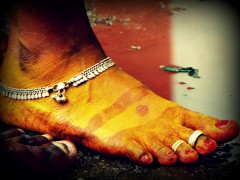 Turmeric is very present in the Indian culture. For example, in Andhra Pradesh, women used to apply it on (and under) the feet every day to protect them (because there were not too many shoes at the time (not that everyone wears shoes today either)). (5)
Turmeric is very present in the Indian culture. For example, in Andhra Pradesh, women used to apply it on (and under) the feet every day to protect them (because there were not too many shoes at the time (not that everyone wears shoes today either)). (5)
Indians may not have invented hot water* (not that they really need it anyways!) but their knowledge about medicinal plants is simply fascinating! Take henna. Not only is it cooling,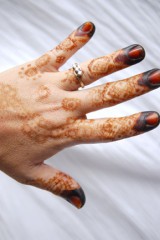 but also it is a coagulant for open wounds. Hence the tradition of Indian women to apply henna on their fingertips to protect themselves from the injuries inherent to manual chores. (6)
but also it is a coagulant for open wounds. Hence the tradition of Indian women to apply henna on their fingertips to protect themselves from the injuries inherent to manual chores. (6)
Here I owe an apology to my mother... After asking a thousand questions she came up with this one: “Tell me, why do these men have orange hair and beard?” I was a little bit upset with myself for not knowing the answer so I just told her whatever non-sense came to my mind: it is because they have used a bad quality dye which has faded!
In fact it seems that some men voluntary decide to have orange hair by dying it with henna. Apparently it could be because some Indians want to hide their gray hair but don’t have enough money to buy a good quality (black) dye. (7) The use of henna can also be linked to religion, as Islam would prohibit any dye except for henna. (8) When I asked my salesguy why do some people have orange hair he just told me that when people start to have gray hair they dye it, sometimes in black, sometimes in orange. No need to overthink it! You see Mum… ;)
* Sheer provocation?? Not only ! Apart from the zero, difficult to think of anything Indians actually invented… It doesn’t mean they are dumb though… They have stuff like the jugaad (in very short, “the gutsy art of overcoming harsh constraints by improvising an effective solution using limited resources”). Read more here.
(2) http://fr.wikipedia.org/wiki/Tilak
(3) http://hinduism.about.com/od/bindis/a/bindi.htm
(4) http://www.safrandugatinais.fr/en/vertus.htm; http://www.healthdiaries.com/eatthis/20-health-benefits-of-turmeric.html
(5) http://www.nandyala.org/mahanandi/?p=925
(6) http://www.ft.com/cms/s/0/d2933fb0-83de-11dc-a0a6-0000779fd2ac.html#ixzz2fW2qoFNh
(7) http://www.earthhenna.com/c158/c105/c98/The-Henna-Plant-c104.html
(8) http://ask.metafilter.com/88073/Why-would-a-Muslim-man-use-henna-to-dye-his-beard-orange
08:00 Posted in Why in India... | Permalink | Comments (0) | Tags: hair, hairs, beard, jugaad, innovation, orange, dye, henna, turmeric, saffron, spices, red dot, red mark, forehead, chakra, energy, meditation, third eye, tika, pottu, sindoor, tilak, tilakam, kumkum, bindi, agna, puja, kumkum powder, vermilion, orange hair | ![]() Facebook | |
Facebook | |















